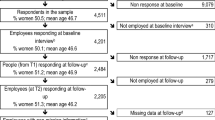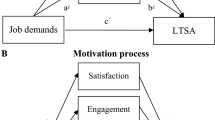Abstract
Objective
To test the hypothesis that psychosocial working conditions are more strongly associated with subsequent work-related emotional exhaustion (core component of burnout) than with depressive symptoms at follow-up.
Methods
A 5-year cohort study (2011/2012–2017), based on a random sample of persons in employment subject to payment of social contributions aged 31–60 years (Study on Mental Health at Work; S-MGA; N = 1949), included self-reported measures of organisational demands (organisational layoffs and restructuring), task-level demands (work pace and amount of work) and job resources (influence at work, possibilities for development, control over working time, role clarity), all taken from the COPSOQ, except the organisational demands that were single-item measures. Work-related emotional exhaustion and depressive symptoms were measured with the Oldenburg Burnout Inventory and the Patient Health Questionnaire-9, respectively.
Results
Cochrane Q tests revealed stronger associations between psychosocial working conditions and work-related emotional exhaustion only for the amount of work (p = 0.013) and control over working time (p = 0.027). No differences were observed for the Demands and Resources Indexes, capturing overall exposure to psychosocial working conditions. The same differences were observed in a subsample including only participants who remained at the same employer from baseline to follow-up, although more psychosocial working conditions were associated with work-related emotional exhaustion than with depressive symptoms. Supplementary analyses employing dichotomous measures of work-related emotional exhaustion and depressive symptoms confirmed these results.
Conclusions
Overall, the findings provide limited evidence supporting the hypothesis that psychosocial working conditions are more strongly associated with work-related emotional exhaustion than with depressive symptoms.

Similar content being viewed by others
Data availability
A scientific use file (SUF) containing both wave 1 and wave 2 of the cohort is available at the Research Data Centre of the Federal Institute of Occupational Safety and Health (https://doi.org/10.48697/smga.w1w2.suf.).
References
Ahola K, Hakanen J (2007) Job strain, burnout, and depressive symptoms: a prospective study among dentists. J Affect Disord 104(1):103–110. https://doi.org/10.1016/j.jad.2007.03.004
Aronsson G, Theorell T, Grape T, Hammarström A, Hogstedt C, Marteinsdottir I, Skoog I, Träskman-Bendz L, Hall C (2017) A systematic review including meta-analysis of work environment and burnout symptoms. BMC Public Health. https://doi.org/10.1186/s12889-017-4153-7
Bianchi R, Schonfeld IS (2018) Burnout-depression overlap: Nomological network examination and factor-analytic approach. Scand J Psychol 59(5):532–539. https://doi.org/10.1111/sjop.12460
Bianchi R, Schonfeld IS, Laurent E (2015) Burnout-depression overlap: a review. Clin Psychol Rev 36:28–41. https://doi.org/10.1016/j.cpr.2015.01.004
Bianchi R, Schonfeld IS, Laurent E (2018) Burnout syndrome and depression. In: Kim Y-K (ed) Understanding depression, vol 2. Clinical Manifestations. Diagnosis and Treatment. Springer Singapore, Singapore, pp 187–202
Bianchi R, Verkuilen J, Schonfeld IS, Hakanen JJ, Jansson-Fröjmark M, Manzano-García G, Laurent E, Meier LL (2021) Is burnout a depressive condition? A 14-sample meta-analytic and bifactor analytic study. Clin Psychol Sci 9(4):579–597. https://doi.org/10.1177/2167702620979597
Börsch-Supan A, Brandt M, Hunkler C, Kneip T, Korbmacher J, Malter F, Schaan B, Stuck S, Zuber S (2013) Data resource profile: the survey of health, ageing and retirement in Europe (SHARE). Int J Epidemiol 42(4):992–1001. https://doi.org/10.1093/ije/dyt088
Burr H, Lange S, Freyer M, Formazin M, Rose U, Nielsen ML, Conway PM (2022) Physical and psychosocial working conditions as predictors of 5-year changes in work ability among 2078 employees in Germany. Int Arch Occup Environ Health 95:153–168. https://doi.org/10.1007/s00420-021-01716-9
Busch MA, Maske UE, Ryl L, Schlack R, Hapke U (2013) Prevalence of depressive symptoms and diagnosed depression among adults in Germany: results of the German health interview and examination survey for adults (DEGS1). Bundesgesundheitsblatt Gesundheitsforschung Gesundheitsschutz 56(5–6):733–739. https://doi.org/10.1007/s00103-013-1688-3
Conway PM, Burr H, Rose U, Clausen T, Balducci C (2021) Antecedents of workplace bullying among employees in Germany: five-year lagged effects of job demands and job resources. Int J Environ Res Public Health 18(20):10805. https://doi.org/10.3390/ijerph182010805
Demerouti E, Bakker AB (2008) The oldenburg burnout inventory: a good alternative to measure burnout and engagement. In: Halbesleben J (ed) Handbook of stress and burnout in health care. Nova Science Publishers, Hauppauge, NY, pp 65–78
Demerouti E, Bakker AB, Nachreiner F, Schaufeli WB (2001) The job demands-resources model of burnout. J Appl Psychol 86(3):499–512
Guseva Canu I, Marca SC, Dell’Oro F, Balázs Á, Bergamaschi E, Besse C, Bianchi R, Bislimovska J, Koscec Bjelajac A, Bugge M, Busneag CI, Çağlayan Ç, Cernițanu M, Costa Pereira C, Dernovšček Hafner N, Droz N, Eglite M, Godderis L, Gündel H, Hakanen JJ, Iordache RM, Khireddine-Medouni I, Kiran S, Larese-Filon F, Lazor-Blanchet C, Légeron P, Loney T, Majery N, Merisalu E, Mehlum IS, Michaud L, Mijakoski D, Minov J, Modenese A, Molan M, van der Molen H, Nena E, Nolimal D, Otelea M, Pletea E, Pranjic N, Rebergen D, Reste J, Schernhammer E, Wahlen A (2021) Harmonized definition of occupational burnout: a systematic review, semantic analysis, and delphi consensus in 29 countries. Scand J Work Environ Health 47(2):95–107. https://doi.org/10.5271/sjweh.3935
Hatch DJ, Potter GG, Martus P, Rose U, Freude G (2019) Lagged versus concurrent changes between burnout and depression symptoms and unique contributions from job demands and job resources. J Occup Health Psychol 24(6):617–628. https://doi.org/10.1037/ocp0000170
International Labor Office Staff (2012) International Standard Classification of Occupations 2008 (ISCO-08): Structure, Group Definitions and Correspondence Tables. International Labour Office, Geneva, Switzerland
Koutsimani P, Montgomery A, Georganta K (2019) The relationship Between burnout, depression, and anxiety: a systematic review and meta-analysis. Front Psychol. https://doi.org/10.3389/fpsyg.2019.00284
Kristensen TS, Borritz M, Villadsen E, Christensen KB (2005) The Copenhagen burnout inventory: a new tool for the assessment of burnout. Work Stress 19(3):192–207. https://doi.org/10.1080/02678370500297720
Kroenke K, Spitzer RL, Williams JB (2001) The PHQ-9: validity of a brief depression severity measure. J Gen Intern Med 16(9):606–613. https://doi.org/10.1046/j.1525-1497.2001.016009606.x
Löwe B, Unützer J, Callahan CM, Perkins AJ, Kroenke K (2004) Monitoring depression treatment outcomes with the patient health questionnaire-9. Med Care 42(12):1194–1201. https://doi.org/10.1097/00005650-200412000-00006
Madsen IEH, Nyberg ST, Magnusson Hanson LL, Ferrie JE, Ahola K, Alfredsson L, Batty GD, Bjorner JB, Borritz M, Burr H, Chastang JF, De Graaf R, Dragano N, Hamer M, Jokela M, Knutsson A, Koskenvuo M, Koskinen A, Leineweber C, Niedhammer I, Nielsen ML, Nordin M, Oksanen T, Pejtersen JH, Pentti J, Plaisier I, Salo P, Singh-Manoux A, Suominen S, Ten Have M, Theorell T, Toppinen-Tanner S, Vahtera J, Väänänen A, Westerholm PJM, Westerlund H, Fransson EI, Heikkilä K, Virtanen M, Rugulies R, Kivimäki M (2017) Job strain as a risk factor for clinical depression: systematic review and meta-analysis with additional individual participant data. Psychol Med 47(8):1342–1356. https://doi.org/10.1017/s003329171600355x
Manea L, Gilbody S, McMillan D (2015) A diagnostic meta-analysis of the patient health questionnaire-9 (PHQ-9) algorithm scoring method as a screen for depression. Gen Hosp Psychiatry 37(1):67–75. https://doi.org/10.1016/j.genhosppsych.2014.09.009
Maslach C, Leiter MP (2016a) Burnout. In: Fink G (ed) Stress: concepts, cognition, emotion, and behavior. Elsevier Science, Amsterdam, Netherlands, pp 351–357
Maslach C, Leiter MP (2016b) Understanding the burnout experience: recent research and its implications for psychiatry. World Psychiatry 15(2):103–111. https://doi.org/10.1002/wps.20311
Meier ST, Kim S (2021) Meta-regression analyses of relationships between burnout and depression with sampling and measurement methodological moderators. J Occup Health Psychol 27(2):195–206. https://doi.org/10.1037/ocp0000273
Niedhammer I, Bertrais S, Witt K (2021) Psychosocial work exposures and health outcomes: a meta-review of 72 literature reviews with meta-analysis. Scand J Work Environ Health 47(7):489–508. https://doi.org/10.5271/sjweh.3968
Nübling M, Stößel U, Hasselhorn H-M, Michaelis M, Hofmann F (2006) Measuring psychological stress and strain at work—evaluation of the COPSOQ questionnaire in Germany. Psycho-Social-Medicine 3:Doc05
Pejtersen JH, Kristensen TS, Borg V, Bjorner JB (2010) The second version of the Copenhagen psychosocial questionnaire. Scand J Public Health 38(3 Suppl):8–24. https://doi.org/10.1177/1403494809349858
Peterson U, Demerouti E, Bergström G, Samuelsson M, Asberg M, Nygren A (2008) Burnout and physical and mental health among Swedish healthcare workers. J Adv Nurs 62(1):84–95. https://doi.org/10.1111/j.1365-2648.2007.04580.x
Rose U, Schiel S, Schröder H, Kleudgen M, Tophoven S, Rauch A, Freude G, Müller G (2017) The study on mental health at work: design and sampling. Scand J Public Health 45(6):584–594. https://doi.org/10.1177/1403494817707123
Rugulies R, Aust B, Madsen IE (2017) Effort–reward imbalance at work and risk of depressive disorders. A systematic review and meta-analysis of prospective cohort studies. Scand J Work Environ Health 43(4):294–306. https://doi.org/10.5271/sjweh.3632
Schaufeli W (2021) The burnout enigma solved? Scand J Work Environ Health 47(3):169–170. https://doi.org/10.5271/sjweh.3950
Schaufeli WB, Taris TW (2005) The conceptualization and measurement of burnout: common ground and worlds apart the views expressed in work & stress commentaries are those of the author(s), and do not necessarily represent those of any other person or organization, or of the journal. Work Stress 19(3):256–262. https://doi.org/10.1080/02678370500385913
Schiel S, Sandbrink K, Aust F, Schumacher D (2018) Mentale Gesundheit bei der Arbeit (S-MGA II)-Methodenbericht zur Wiederholungsbefragung von Erwerbstätigen in Deutschland 2017. Bundesanstalt für Arbeitsschutz und Arbeitsmedizin, Dortmund/Berlin/Dresden
Schmitt M, Altstötter-Gleich C, Hinz A, Maes J, Brähler E (2006) Normwerte für das Vereinfachte Beck-Depressions-Inventar (BDI-V) in der Allgemeinbevölkerung [norm values for the simplified beck depression inventory (BDI-V) in the general population]. Diagnostica 52(52):8
Schonfeld IS, Verkuilen J, Bianchi R (2019) An exploratory structural equation modeling bi-factor analytic approach to uncovering what burnout, depression, and anxiety scales measure. Psychol Assess 31(8):1073–1079. https://doi.org/10.1037/pas0000721
Spitzer RL, Kroenke K, Williams JB (1999) Validation and utility of a self-report version of PRIME-MD: the PHQ primary care study. Primary care evaluation of mental disorders. Patient health questionnaire. JAMA 282(18):1737–1744. https://doi.org/10.1001/jama.282.18.1737
Theorell T, Hammarström A, Aronsson G, Träskman Bendz L, Grape T, Hogstedt C, Marteinsdottir I, Skoog I, Hall C (2015) A systematic review including meta-analysis of work environment and depressive symptoms. BMC Public Health. https://doi.org/10.1186/s12889-015-1954-4
Warr P (2011) Work, happiness, and unhappiness. Psychology Press, NY
Wirth H, Gresch C, Müller W, Pollak R, Weiss F (2009) Validating the ESeC-scheme as operationalization of social class the case of Germany. Mannheimer Zentrum für Europ. Sozialforschung, Mannheim
Acknowledgements
The Study on Mental Health at Work (S-MGA) was conducted in collaboration with the Institute for Employment Research (IAB). The S-MGA was based on samples from statistics of the Federal Employment Agency (BA), which were merged into Integrated Employment Biographies by the IAB. We thank the participating employees and Infas (Institute of Applied Social Sciences) for collecting the data.
Funding
The 2011/2012 and 2017 rounds of the S-MGA study were funded internally by the BAuA (project no. F 2250 and F 2384). This article was written as part of the project “Mental health and work participation” at the BAuA (internally funded project no. F 2462).
Author information
Authors and Affiliations
Corresponding author
Ethics declarations
Conflict of interest
The authors have no conflicts of interest to declare.
Ethical approval
The study was conducted according to the guidelines of the Declaration of Helsinki and was approved by the Ethics Committee of the Federal Institute for Occupational Safety and Health (BAuA; approval number 006_2016_Müller, 6 March 2016). All employees in the sample were contacted by mail and the interviews were only conducted after each respondent gave their informed oral consent (Rose et al. 2017). A written consent was given for the willingness to participate in the follow-up.
Additional information
Publisher's Note
Springer Nature remains neutral with regard to jurisdictional claims in published maps and institutional affiliations.
Supplementary Information
Below is the link to the electronic supplementary material.
Rights and permissions
Springer Nature or its licensor (e.g. a society or other partner) holds exclusive rights to this article under a publishing agreement with the author(s) or other rightsholder(s); author self-archiving of the accepted manuscript version of this article is solely governed by the terms of such publishing agreement and applicable law.
About this article
Cite this article
Conway, P.M., Rose, U., Formazin, M. et al. Long-term associations of psychosocial working conditions with depressive symptoms and work-related emotional exhaustion: comparing effects in a 5-year prospective study of 1949 workers in Germany. Int Arch Occup Environ Health 96, 661–674 (2023). https://doi.org/10.1007/s00420-023-01959-8
Received:
Accepted:
Published:
Issue Date:
DOI: https://doi.org/10.1007/s00420-023-01959-8




